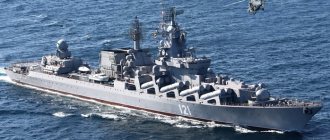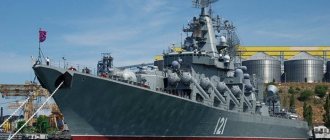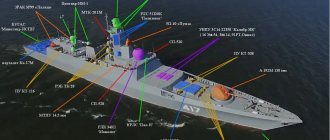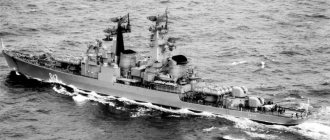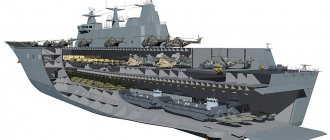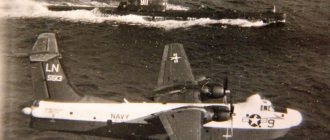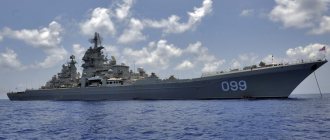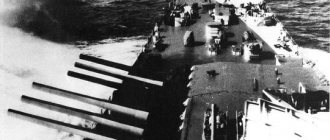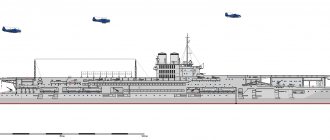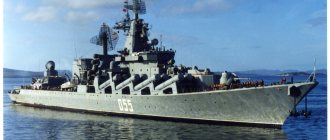In April 1972, the Commission under the Council of Ministers of the USSR decided to develop Project 1164 (code “Atlant”). At first it was planned to build 10 ships of the Atlant series, but in the end 4 were laid down, and only 3 were put into operation, including the most important ship of Project 1164, the cruiser Moskva.
Today, this flagship of the Black Sea Fleet is the only ship of the 1st rank. Let's take a closer look at the history of the creation of the cruiser "Moscow", its technical characteristics and features.
History of creation
The history of this ship very accurately repeats the history of the state in which it was developed and built.
The cruiser was laid down on the slipway of the Nikolaev Shipyard named after. 61 Communards on November 4, 1976, she was the first in a series of six new Soviet gas turbine cruisers, Project 1164 Atlant. The ship received the name “Slava” and was launched on July 27, 1979, entered service at the end of 1982, and in February 1983 was included in the Red Banner Black Sea Fleet, where until 1990 it was the main striking force of the fleet.
In 1991, he stood on the stocks of the Nikolaev plant for routine repairs and modernization; eight months were allotted for this. But with the collapse of the USSR, funding for repairs also stopped, or rather, it did not even begin. Years passed, the cruiser was preserved only thanks to the personal contribution of the crew, only five years later there was hope for rectifying the situation. Thanks to the personal efforts of Yuri Luzhkov and the patronage of the Moscow City Hall, it was possible to find funds to complete the repairs.
On June 22, 1995, by order of the Commander-in-Chief of the Russian Navy, the cruiser received a new name - “Moscow”. On June 12, 1997, the St. Andrew's flag was raised on the ship. Only on July 19, 1999, the cruiser left Nikolaev, and on July 21 the ship entered Sevastopol Bay. On July 25, Russian Navy Day, the flagship of the Russian Black Sea Fleet stood in parade formation in Sevastopol Bay. In April 2000, for the first time in 10 years, the Moskva went to sea to check its propulsion mechanisms and check its weapons. That same summer I personally saw him at a parade when I took this photo. In November, the cruiser became part of the permanent readiness forces.
Over the past two decades, the cruiser has taken part in sea voyages, international exercises, combat and peacekeeping operations, and ensured the security of the Winter Olympic Games in Sochi. In total, the ship served in 19 combat missions, including in the Atlantic, Pacific and Indian Oceans.
The main striking force of the cruiser is 16 launchers of the Vulcan complex. "Vulcan" is a Soviet/Russian anti-ship missile system (ASM). It is a development of the P-500 “Basalt” system.
On July 22, 2016, Russian Minister of Defense General of the Army Sergei Shoigu awarded the Order of Nakhimov to the guards missile cruiser "Moscow" in accordance with the Decree of the President of Russia "For services to ensuring the security of the state, high performance in combat training, courage and dedication shown by personnel during performing combat training missions"
On June 5, 2022, after three years of repairs, she went to sea to undergo sea trials of the main power plant after a major overhaul.
Anti-submarine cruiser "Moscow" pr. 1123
The appearance of nuclear submarines with ballistic missiles on board in the US Navy revealed the need to replenish our fleet with new types of anti-submarine ships. To combat enemy submarines, it was decided to use helicopters. Since 1962, the fleet began to receive patrol ships of the Komsomolets of Ukraine type with one Ka-25 helicopter on board. But single basing did not provide combat effectiveness sufficient to solve the problem. Group basing was necessary, in which it was possible to organize shift work of helicopters to search for submarines within a strip of considerable width.
The first studies on the design of such a ship at TsKB-17, the institutes of the State Committee for Shipbuilding, the Navy and the Air Force began in 1958. The direct design of the ship was led by the chief designer of TsKB-17, A.S. Savichev (in March 1967, he was replaced by A.V. Marinich). General management was carried out by the head of the Central Clinical Hospital B.G. Chilikin. On December 3, 1958, a resolution was issued by the Central Committee of the CPSU and the Council of Ministers of the USSR, in which the creation of a long-range anti-aircraft submarine was characterized as one of the priority tasks of domestic shipbuilding. Soon, the Commander-in-Chief of the Navy, S.G. Gorshkov, approved the operational and technical specifications for the development of the project, designated 1123.
Construction of the lead anti-submarine cruiser of Project 1123 “Moscow” (serial number 701) began on December 15, 1962 at the Nikolaev shipyard No. 444 named after. I.I. Nosenko (former No. 198 named after A. Marti).
On January 14, 1965, the ship was launched, and on January 27, it was added to the list of Navy ships. In March 1965, the formation of the crew began. On April 16, 1967, the USSR Naval Flag was solemnly raised on the ship.
Sea and state tests took place from April 21 to November 3. On January 10, 1968, the ship was included in the 21st brigade of anti-submarine ships of the KChF (note that it was originally intended to include it in the KSF).
The ship had a high-sided hull made of steel using a longitudinal casting system with a 500 mm spacing. The take-off and landing site with 4 starting positions was located in the aft part (the most protected from being flooded by waves). All weapon systems were located in the bow. In the center there was a multi-tiered superstructure combined with a chimney and a tower-like mast. The superstructure was made of aluminum-magnesium alloys. Unsinkability was ensured by 16 main watertight bulkheads that reached the hangar deck. Along the entire length of the hull there was a double bottom, which turned into a double side. The power plant consisted of 2 GTZA TV-12 and 4 KVN-95/64 steam boilers with external economizers. In order to reduce the hydroacoustic field in the foundations of the main and auxiliary mechanisms, shock absorbers were widely used (for the first time on a large ship). To reduce the thermal field, the exhaust gases were cooled by electors located inside the pipe. To protect against non-contact magnetic mines and torpedoes, a demagnetizing device consisting of 4 windings is installed.
There were 14 Ka-25 helicopters on board the ship (12 of them in a large hangar under the flight deck and 2 in a small one on the upper deck). The helicopters were lifted onto the flight deck using 2 lifts. The ship's armament consisted of 2 twin launchers of the M-11 "Storm" air defense system (96 missiles), one installation of the RPK-1 "Whirlwind" anti-submarine missile system (8 missile-torpedoes), 2 double-barreled 57-mm artillery mounts AK-725, 2 RBU-6000 rocket launchers (96 RSL-60 depth charges). Initially, 2 five-tube 533-mm torpedo tubes PTA-53-1123 were also installed (dismantled in 1976). The radio equipment included: the lowered GAS "Orion", the towed GAS "Vega", the GAS "Khosta" for communication with their boats, the three-dimensional long-range radar "Voskhod", the backup radar "Angara-A", the television system "Kuznechik", night vision visor "Agate". All information from radar, hydroacoustic and optical means entered the combat information and control system “Koren-1123” (for the first time in the domestic fleet). Also, for the first time, a complete set of electronic warfare equipment was installed - two Zaliv radar reconnaissance stations, intended for detection and direction finding of enemy radio equipment, two Gurzuf universal counter-jamming stations, creating synchronous pulse and noise interference to aircraft and radar sights, and two launchers ZIF-121 for firing projectiles with dipole reflectors and thermal (infrared) traps. For the repair of radio-electronic equipment there was a workshop KRM-1123.
Project 1123 cruisers were fundamentally new ships of the Russian fleet in all respects - in design, composition of missile and electronic weapons, and tactics of use. They were intended to search for and destroy fast nuclear missile-carrying submarines in distant anti-submarine defense zones as part of a group of ships in cooperation with anti-aircraft aircraft (during cruises, one squadron 78 OKPLVP was based on board the cruiser). The ships had powerful radar and sonar detection systems, modern missile systems, the most advanced electronic warfare systems in the world, and a high level of automation. In terms of search performance, the Project 1123 cruiser was several times superior to the Project 61 BOD. The disadvantages include insufficient seaworthiness, cramped quarters, fire hazard due to the widespread use of aluminum-magnesium alloys in the design and the unreliable Karat-M fire extinguishing system, and weak anti-aircraft weapons.
The cruiser went to the Mediterranean Sea for combat service 11 times, and went to the Atlantic Ocean twice. He participated in major exercises “Spring” (1969), “Armor” (1969), “Ocean” (1970). On April 8-13, 1970 and April 26-29, 1973, the cruiser paid visits to Alexandria (Egypt), June 5-10, 1974 and April 12-19, 1982 - to Rijeka (Yugoslavia), April 8-13, 1978 - to Algeria, September 27 - October 5, 1979 - to Dubrovnik (Yugoslavia), June 12-18, 1982 - to Luanda (Angola), June 25 - July 2, 1982 - to Lagos (Nigeria), August 10-11, 1991 - to Varna (Bulgaria), November 20-25, 1991 - to Tartus (Syria). On November 18, 1972, the Yak-36M vertical take-off aircraft (test pilot M.A. Dexbach) landed on the deck of the Moskva anti-ship missile system for the first time.
In March 1974, the Moskva anti-ship missile system, while in a war zone, carried out a combat mission to assist the Egyptian armed forces.
Since 1976, the cruiser was part of the 11th brigade of the 30th division of the Red Black Sea Fleet. In 1982-1989, the ship underwent repairs at Sevmorzavod.
The last trip to sea took place on May 26, 1993. On April 27, 1994, the cruiser was transferred to category 2 reserve. On June 22, 1995, it was renamed “RPK on board No. 108” (the name “Moscow” was given to the missile cruiser “Slava” pr.1164). On November 7, 1996, the Naval flag was ceremoniously lowered. On May 27, 1997, the ship was towed from Sevastopol to India for cutting into metal.
The appearance of the helicopter-carrying cruisers "Moscow" and "Leningrad" in the Soviet Navy was an event that had a huge impact on the further evolution of domestic naval policy. These were fundamentally new ships in all respects - in design, composition of missile and electronic weapons, and tactics of use. It is from them that our aircraft-carrying cruisers trace their ancestry, giving the fleet a long-awaited and much-needed “air umbrella” in modern warfare. “The anti-submarine cruiser “Moskva” represents the most advanced type of ship,” said Navy Commander-in-Chief Admiral S.G. Gorshkov, usually stingy with praise. “Many of the latest models of military equipment are concentrated on this ship, which gives it exceptionally strong combat qualities.” The helicopter carrier cruiser deservedly received such high praise: it embodied the most progressive scientific and technical ideas and solutions, which in a number of aspects were even ahead of their time.
Design
On Atlant-class cruisers, the emphasis was placed on gas turbine propulsion systems. Firstly, their cost was lower compared to nuclear fuel engines. And secondly, in this way it was possible to reduce the technical dimensions and displacement.
In addition, the use of light alloys in the design of the missile helicopter carrier allowed it to meet the calculated displacement parameters. The Atlant series missile flagships were to become full-fledged ocean-going ships with powerful missile weapons.
By its design, the anti-submarine cruiser Moscow is a two-masted ship that has a developed three-island superstructure.
Thanks to the inclined stem and frames with a large camber, it was possible to improve the seaworthiness of the vessel.
Most of the hull is made of ship steel, internal bulkheads and partitions are made of durable aluminum alloys. Deck superstructures were constructed in the same way, which were additionally reinforced with steel sheets at the launch sites of combat missiles. The rigging was made from the same aluminum alloys.
And thanks to the double bottom under the fuel tanks, the distribution of ammunition magazines in different parts of the ship and a well-thought-out fire-fighting system, the survivability of Moscow was increased. Even if three adjacent compartments were flooded, the ship could remain afloat without loss of combat effectiveness.
Armament of the “aircraft carrier killer”
The Atlant series ships were created for the new Basalt anti-ship missiles, which have great destructive power. However, later the flagship of the Black Sea Fleet was re-equipped with more powerful Vulcan anti-ship missiles, which made it possible to increase firepower. And along with the reduced mass of the warhead, the firing radius of the missile has increased significantly.
Today the armament of the missile cruiser Moscow consists of:
- anti-ship - Vulcan complex (16 launchers);
- anti-submarine - two five-tube torpedo tubes;
- two rocket launchers RBU - 6000;
- anti-submarine helicopter KA-25/27 with a hangar and helipad;
- two-gun shipborne artillery mount AK-130;
- eight S-300F Fort air defense systems;
- two Osa-MA air defense systems.
Not long ago, a decision was made to modernize the flagship of the Black Sea Fleet, the cruiser Moscow.
It is planned to replace the Vulcan with modern Onyx anti-ship missiles and ultra-precise Calibers. Perhaps the S-300F and Osa-M anti-aircraft systems will be replaced.
Anti-submarine cruisers Project 1123, code “Condor”
Quantity
2 pieces
Construction
Nikolaev, Black Sea Shipyard
Name
| Factory | Pawned | Launched | Commissioning | Note | |
| Moscow | №701 | 15.12.1962 | 14.01.1965 | 25.12.1967 | from 05/15/1995 PKR-108 |
| Leningrad | №702 | 15.01.1965 | 31.07.1966 | 2.06.1969 |
Tactical and technical data
| Displacement, t: | |
| standard: | 11920 |
| complete: | 15280 |
| Dimensions, m: | |
| length max/KVL: | 189 |
| width max/KVL: | 34 |
| draft: | 7,7 |
| Hangar dimensions, m: | 50 x 22 x 5.8 |
| Full speed, knots: | 28,5 |
| Cruising range: | 9000 miles (15 kts), 6000 miles (18 kts), 4000 miles (28.5 kts) |
| Autonomy, days: | 15 |
| Power point: | 2x45000 hp, GTZA TV-12, 2 fixed propeller propellers, 2 TD-1500 TGs 1500 kW each, 2 diesel generators 1500 kW each |
| Weapons: | 12 Ka-25 anti-submarine helicopters 1 Ka-25PS search and rescue helicopter 1 Ka-25Ts target acquisition helicopter 2x2 B-189 launchers UZRK M-11 “Storm” (96 V-611 (4K60) missiles) – 2 “Grom-M” control system 2x2 57 mm AK-725 – 2 MR-103 “Bars-72” control system 1x2 MS-32 RPK-1 “Vyuga” launcher (8 82R PLUR) – PUSTB-1123 “Sprut” control system 2x5 533 mm PTA-53-1123 ( 10 torpedoes SET-53, SET-65) – removed in 1975 2x12 RBU-6000 “Smerch-2” (120 RGB-60) |
| RTV: | General detection radar MR-600 "Voskhod", general detection radar MR-310 "Angara-A", navigation radar "Don", electronic warfare radar "Gurzuf", electronic warfare radar "Gurzuf-1", RTR radar MRP-11-16 "Zaliv" ", state identification equipment "Kremniy-2M" (interrogator "Nickel-KM", 2 transponders "Khrom-KM", interrogator-responder "Nichrom-M"), radio direction finder ARP-50, GAS MG-342 "Orion", BUGAS MG -325 “Vega”, sonar underwater communication system MG-26 “Khosta”, BIUS MVU-201 “Koren-1123” Electronic warfare complex PK-2 (2 ZIF-121 launchers) – rounds AZ-TST-41, AZ-PTST-41 , AZ-TSP-47, AZ-TST-47, AZ-TSV-47, AZ-TSO-47 (since 1985), AZ-TSR-47 (since 1991) – SU “Tertsia” |
| Crew, persons: | 700 (130 officers, 160 midshipmen) (then 850 people) |
General form
Project 1123 anti-submarine cruisers – General view
Modernization of the project
In Leningrad in 1979 a radio direction finder "Rumb" was installed. Unimplemented modifications: Project 11233 - with enhanced defensive weapons
Distribution by fleet
Black Sea Fleet
: Leningrad, Moscow
Side numbers
Leningrad: 848(1969), 845(1969), 844(1972), 853(1973), 854(1973), 847(1974), 857, 842(1975?), 858(1976), 103(1978), 107(1979), 113(1981), 103(1984), 428(1987), 109(1988), 106(1990), 702(1994) Moscow: 155, 857(1968), 851(1969), 859, 848(1970), 841(1970), 854(1972), 843(1973), 852, 846(1974), 850(1977), 848(1977), 841, 853, 847(1978), 851(1978) , 104(1979), 100(1980), 106(1982), 110(1988), 108(1990)
Write-off
1991 - Leningrad (24.06) 1996 - Moscow (8.07)
Export
—
Technical characteristics of Moscow and foreign analogues
To compare the characteristics of our cruiser Moscow and its foreign counterpart, the American Ticonderoga is most suitable, since representatives of this type have similar weapons to our ship. In addition, the design of these ships was carried out almost simultaneously on opposite sides of the ocean.
| Specifications | Russian anti-submarine cruiser Moscow | American Ticonderoga-class cruiser |
| Displacement, tons | 11380 | 9600 |
| Size, m | 186 length, 20.8 width | 172.8 length, 16.8 width |
| Power plant | gas turbine unit: 4 x 22.5 thousand hp. and 2 x 10 thousand hp. | 4 gas turbine units operating on two shafts with a capacity of 80 thousand hp. |
| Travel speed, knots | 34 | 30 |
| Cruising range, miles | 6000 (at 15 knots) and 2500 at 30 knots | 6000 |
| Crew, man | 510 | 360 |
Based on the characteristics that were given in the table, it is easy to guess that the flagship, which has become the pride of the Black Sea Fleet, is significantly superior to its American counterpart in certain parameters.
About Northern "Atlanta"
Repairs of the Marshal Ustinov began in 2011 by shipbuilders. Work was carried out on the ship's hull, the mechanisms of the propeller group, the main power plant, and the general ship systems of the cruiser. Electronic weapons systems were modernized, replacing analogue devices with digital ones.
The company noted that the experience gained by Zvezdochka during the repair of the Marshal Ustinov will reduce the repair time of the cruisers Moskva and Varyag of the same type.
“They gained experience in repairing surface ships even earlier, when they modernized the Fearless ship of Project 956 (in 2004 it changed its name to Admiral Ushakov). Then they made an aircraft carrier. It is obvious that this repair period will be shorter, taking into account this experience that was gained earlier,” said Igor Kasatonov (Adviser to the Chief of the General Staff of the Russian Armed Forces, Admiral).
At the end of October 2016, “Marshal Ustinov” went to sea to carry out the factory sea trials program. Numerous checks of the cruiser's systems and mechanisms in sea conditions, which lasted about a month, confirmed the ship's high performance characteristics.
Project evaluation
In total, 4 cruisers were laid down under Project 1164, of which 3 vessels were completed and entered service - one of each of them is serving in the Northern, Black Sea and Pacific fleets of Russia. In general, we can admit that the Project 1164 missile cruisers were a fairly successful alternative to the overly expensive Project 1144 Orlan heavy missile cruisers. Having a limited displacement, Project 1164 missile cruisers had virtually equivalent offensive weapons and comparable defensive weapons.
Moreover, priority in their creation was given not to defensive, but to offensive weapons. The ships have a reduced supply of missiles for the S-300F air defense system - 64 versus 96 on the Orlans, and the weak point is the self-defense air defense, which consists of only 2 outdated Osa-M air defense systems. Project 1144 cruisers have 16 Kinzhal launchers. In general, the ships of Project 1164 corresponded to the “late” doctrine of the Soviet fleet - the use of attack surface missile carriers under the cover of carrier-based aircraft.
The cruiser's biggest drawbacks include the presence of only one multi-channel target illumination radar for the S-300F air defense system (Volna radar). In addition to leaving the ship without adequate protection if it malfunctions, it also prevents the cruiser from repelling an attack from more than one direction at a time.
For comparison, comparable-sized American Ticonderoga-class cruisers have 4 independent target illumination radars, which allows them to repel simultaneous attacks from more than one direction. The presence of only one guidance radar significantly reduces the ability of Project 1164 ships to combat modern anti-ship missiles with multi-sector attack capabilities.
The revived cruiser "Condor" will solve the main problems of the Russian Navy
And again about our navy, its needs and aspirations.
The main problems of the Russian Navy include the small number of large surface ships in the far sea and ocean zones, as well as the virtual absence of aircraft carriers. (The long-suffering TAVRK "Admiral Kuznetsov" is undergoing modernization, the terms of which are continuously being extended). This painful topic is the subject of constant heated discussions, so we will now add a little fuel to this flame. If you look at the number and age of our cruisers, the numbers are depressing. TARK "Peter the Great" was launched in 1989. The flagship of the Northern Fleet will soon undergo a deep modernization, which should extend its service life and increase its combat effectiveness. It will be replaced by our second heavy nuclear cruiser, Admiral Nakhimov, launched in 1986. This ship has formally been undergoing repairs since 1999, but in reality it only began in 2013 and continues to this day. The flagship of the Black Sea Fleet, the missile cruiser Moskva, was launched in 1979. Its fellow Project 1164 cruiser “Varyag” (1983) is at the head of the Pacific Fleet. Our third and last Atlant, the missile cruiser Marshal Ustinov, is part of the Northern Fleet. These are our largest and most combat-ready ships in the distant sea and ocean zones. As you can see, they are all quite old and need deep modernization. The project of the nuclear-powered missile destroyer Leader, which was supposed to replace Soviet-built cruisers, was shelved due to its extreme high cost (100 billion rubles per unit).
It becomes even sadder when looking at our only aircraft carrier, Admiral Kuznetsov. During the trip to Syria, the TAVRK did not show its best side, and then almost drowned during a scheduled repair due to an emergency at a shipyard. The situation with the Project 23900 universal landing ships looks somewhat more optimistic. Two such UDCs with a total displacement of 40 thousand tons have been laid down and are being built in Kerch. They can be used not only for transporting troops and military equipment, but also for basing up to 16 helicopters, as well as UAVs. For the Russian Navy, the appearance of such helicopter carriers will be a big positive step forward. However, it should be taken into account that their commissioning is expected only at the turn of 2027-2028, and also that each such UDC, being the core of a naval formation and its command headquarters, needs escort ships and their constant protection.
In the humble personal opinion of the author of the lines, the Russian Navy needs not only frigates of projects 22350 and 22350M, but also larger attack ships in the far sea and ocean zone, as well as aircraft-carrying ships. Heavy aircraft carriers with a nuclear power plant like the Nimitz or Ulyanovsk are beyond our means, and there are no tasks for them yet, so a compromise option would be to create a series of 2-3 light aircraft carriers with a displacement of 40-45 thousand tons and an air wing up to 40 aircraft. We talked in detail about one of the possible projects that meets these requirements earlier. But, as you know, aviation is different. I would like to talk about such a rather promising direction as drone ships.
The Americans were, of course, the first to look at UAVs as sea-based unmanned aircraft. Drones can be tactical, operational-tactical and strategic or high-altitude long-range. Their tasks are reconnaissance and target designation of strike weapon systems, long-range reconnaissance and surveillance, as well as reconnaissance and suppression of enemy air defense systems, provoking its guidance systems to turn on active channels. As these technologies develop, UAVs will be assigned more and more new tasks: visual and electronic reconnaissance, electronic warfare, combat against surface and underwater targets, air defense, search for minefields and mine banks, as well as support for landing operations. In general, ship-based unmanned aircraft have a bright future. At the same time, UAVs are cheaper and more compact than airplanes, and they do not require pilots, who must be trained and trained for many years.
Naturally, the US Navy managed to advance the furthest in this area. Let us note, for example, the RQ-8A and MQ-8B helicopter-type UAVs, as well as the Eagle Eye HV-911 unmanned tiltrotor. Their European allies were very interested in the Americans’ developments in the field of maritime reconnaissance and attack drones. It is worth mentioning the grandiose plans that Ankara is building. At the end of 2021, the Turkish Navy will receive its own UDC called Anadolu. It was initially assumed that the light aircraft carrier would be equipped with the fifth-generation F-35 fighter jets, but due to political differences, Washington refused to sell them to President Erdogan. Finding themselves in an uncomfortable situation, the Turks began to improvise and found a very successful option: to place 30 to 50 Bayraktar TB2 attack UAVs on their universal landing ship. The manufacturer is currently creating a deck version of them, and the drones, which became famous in recent campaigns, can be used for reconnaissance, air strikes against coastal targets with weak air defense, and also as a carrier of sonar buoys to search for enemy submarines.
As we see, need forced Turkey to de facto create the first drone carrier ship. At the same time, Ankara has not yet abandoned plans to build a full-fledged large aircraft carrier, presumably according to a British design. And what can the Russian Navy answer to this to its potential opponents? In fact, there are some options.
On the one hand, yes, we are quite behind the United States and its allies in the field of UAVs, but in the last couple of years there has been a noticeable breakthrough. We now have the Orion attack drones, which can be a real competitor to the Turkish Bayraktar TB2, the Altius reconnaissance drone and the S-70 Okhotnik super-heavy attack drone. The latter, by the way, can be used in tandem with the fifth-generation fighter Su-57 as a wingman. This means that Russia has begun to catch up with competitors in the field of unmanned aircraft, and now it seems appropriate to create a maritime version of these drones.
On the other hand, the “damaged” UAVs will be able to be based on both Russian UDCs under construction and even on the Admiral Kuznetsov after it returns to service. If desired, light aircraft carriers, which we mentioned above, can be used as drone carriers, if a decision is made to build them. Thanks to this, “aircraft carrier-phobes” can stop worrying about the high cost of a carrier-based aircraft wing, since UAVs are significantly cheaper than airplanes. Perhaps in the future, the naval version of the Hunter will be able to interact in tandem with fighters, increasing their effectiveness. But this is not all the options for the Russian Navy to acquire aircraft-carrying multifunctional ships.
The fact that Russia has one long-standing project that can get a new life today was written in an article for the Center for International Maritime Security (CIMSEC) by Polish military expert Przemyslaw Zemacki, who closely monitors the achievements of the domestic military-industrial complex. In his opinion, the Project 1123 anti-submarine cruiser-helicopter carrier may be the optimal platform for deploying carrier-based unmanned aircraft:
Today, when full-size aircraft carriers are becoming increasingly vulnerable due to long-range missiles, including land-based missiles, the Moscow-class project may once again emerge from the shadows of history... They were either well armed or could easily increase their armament, had relatively large flight decks and hangars.
Let's remember in general terms the Soviet project 1123 "Condor", which preceded the "Krechet" and the subsequent TAVRCs of the "Admiral Kuznetsov" type. Only two helicopter carrier cruisers, Moskva and Leningrad, were built for the needs of anti-submarine warfare and to provide combat stability to the forces of the USSR Navy in the far sea zone. The ships had a total displacement of 15,280 tons and a rather unusual appearance due to the wide rear deck, where 14 helicopters could be based at once. But, in addition to anti-submarine helicopters, the Condors also carried quite serious anti-aircraft missiles and anti-submarine weapons. But does it make sense to return to a long-forgotten project?
It is possible that there is some meaning in this. Subject to modernization to modern conditions, Project 1123 cruisers can be equipped with powerful missile weapons; its hull will accommodate at least 96 universal launch cells for Caliber, Onyx and Zircon. These will be serious large ships of the distant sea and ocean zone, comparable in strike potential to the American Arleigh Burkes and approaching the Ticonderogas. But at the same time, they will surpass them in functionality due to the ability to accommodate an air wing. These can be both anti-submarine helicopters and AWACS helicopters, as well as UAVs, reconnaissance and attack, which we discussed above. Compare for yourself: the Project 23900 UDC can accommodate up to 16 rotorcraft, and the Condor - 14. Almost on par, but at the same time, the universal landing ship is de facto defenseless, it must be guarded by other ships, and the Project 1123 cruiser, armed with anti-ship and cruise missiles, in itself represents a serious combat unit.
In fact, being adapted to modern realities, the Condors will be able to close the failure of the Russian Navy in large surface ships of the distant sea and ocean zone, and in helicopter carriers, and at the same time occupy the promising niche of a drone carrier, partially compensating for Russia’s lack of aircraft carriers.
